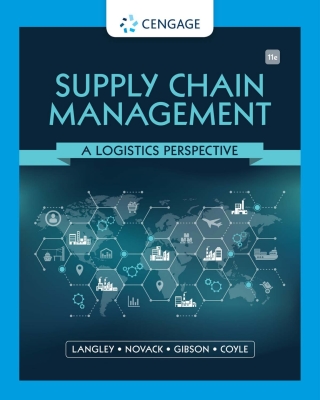Buy Supply Chain Management: A Logistics Perspective, 11th Edition PDF ebook by author C. John Langley; Robert A. Novack; Brian Gibson – published by Cengage Learning in 2021 and save up to 80% compared to the print version of this textbook. With PDF version of this textbook, not only save you money, you can also highlight, add text, underline add post-it notes, bookmarks to pages, instantly search for the major terms or chapter titles, etc.
You can search our site for other versions of the Supply Chain Management: A Logistics Perspective, 11th Edition PDF ebook. You can also search for others PDF ebooks from publisher Cengage Learning, as well as from your favorite authors. We have thousands of online textbooks and course materials (mostly in PDF) that you can download immediately after purchase.
Note: e-textBooks do not come with access codes, CDs/DVDs, workbooks, and other supplemental items.
eBook Details:
Full title: Supply Chain Management: A Logistics Perspective, 11th Edition
Edition: 11th
Copyright year: 2021
Publisher: Cengage Learning
Author: C. John Langley; Robert A. Novack; Brian Gibson
ISBN: 9780357132296, 9780357132302
Format: PDF
Description of Supply Chain Management: A Logistics Perspective, 11th Edition:
Using a reader-friendly, straightforward, yet interesting, approach, Langley/Novack/Gibson/Coyle’s SUPPLY CHAIN MANAGEMENT: A LOGISTICS PERSPECTIVE, 11E blends logistics theory with practical applications. The latest content highlights emerging issues, technology developments, and global changes in the constantly evolving field of supply chain management. Learn how today’s public and private organizations are responding to the continual pressure to modernize and transform their supply chains. Updated features and short cases offer hands-on managerial experience with the opportunity to examine key decisions and circumstances that supply chain managers face daily. New profiles introduce each chapter with real organizations, people, or events that emphasize the importance of what you are learning. Technology-focused features and global content examine key areas where change is occurring and provide a meaningful perspective on how today’s changes impact current and future supply chains.Important Notice: Media content referenced within the product description or the product text may not be available in the ebook version.
Table of Contents of Supply Chain Management: A Logistics Perspective, 11th Edition PDF ebook:
DedicationBrief ContentsContentsPrefaceAbout the AuthorsPart IChapter 1: Supply Chain Management: An Overview1-1 Introduction1-2 Shaping the Supply Chains of the Twenty-First Century: Evolution and Change1-3 Supply Chains: Development and Shaping for the Twenty-First Century1-4 Major Supply Chain IssuesSummaryStudy QuestionsCase 1.1: Lehigh Valley Transport and Logistics Service (LVTLS)Case 1.2: Central Transport, Inc.Chapter 2: Global Dimensions of Supply Chains2-1 Introduction2-2 Rationale for Global Trade and Commerce2-3 Contributing Factors for Global Commerce and Supply Chain Flows2-4 Global Supply Chain Flows2-5 Supply Chains in a Global Economy2-6 Global Markets and Strategy2-7 Supply Chain Security: A Balancing Act2-8 Ports2-9 North American Free Trade AgreementSummaryStudy QuestionsCase 2.1: Red Fish-Blue Fish, LLPCase 2.2: Nike, Inc. Global Supply Chain StrategyChapter 3: Role of Logistics in Supply Chains3-1 Introduction3-2 What Is Logistics?3-3 Value-Added Roles of Logistics3-4 Logistics Activities3-5 Logistics in the Economy: A Macro Perspective3-6 Logistics in the Firm: The Micro Dimension3-7 Logistics in the Firm: Factors Affecting the Cost and Importance of LogisticsSummaryStudy QuestionsCase 3.1: Jordano Food ProductsCase 3.2: Senco Electronics CompanyAppendix 3A: Techniques of Logistics System AnalysisAppendix 3B: Approaches to Analyzing Logistics SystemsChapter 4: Supply Chain and Omni-Channel Network Design4-1 Introduction4-2 The Need for Long-Range Planning4-3 Supply Chain Network Design4-4 Major Locational Determinants4-5 Modeling Approaches4-6 Omni-Channel Network DesignSummaryStudy QuestionsCase 4.1: Home Depot’s Supply Chain TransformationCase 4.2: Bigelow StoresAppendix 4A: Grid Method-Sensitivity Analyses and Application to Warehouse Location in a CityPart IIChapter 5: Sourcing Materials and Services5-1 Introduction5-2 Types and Importance of Items and Services Acquired5-3 Strategic Sourcing Process5-4 Supplier Evaluation and Relationships5-5 Total Landed Cost (TLC)5-6 E-Sourcing and E-Procurement5-7 E-Commerce ModelsSummaryStudy QuestionsCase 5.1: Alligator, Inc.Case 5.2: Trans-Changi, Inc.Appendix 5A: The Special Case of Procurement PriceChapter 6: Producing Goods and Services6-1 Introduction6-2 The Role of Production Operations in Supply Chain Management (SCM)6-3 Operations Strategy and Planning6-4 Production Execution Decisions6-5 Production Metrics6-6 Production TechnologySummaryStudy QuestionsCase 6.1: Hudson GuitarsCase 6.2: War Eagle Golf Ltd.Chapter 7: Demand Management7-1 Introduction7-2 Demand Management7-3 Balancing Supply and Demand7-4 Traditional Forecasting7-5 Forecast Errors7-6 Forecasting Techniques7-7 Sales and Operations Planning7-8 Collaborative Planning, Forecasting, and ReplenishmentSummaryStudy QuestionsCase 7.1: Tires for You, Inc.Case 7.2: Playtime, Inc.Chapter 8: Order Management and Customer Service8-1 Introduction8-2 Influencing the Order-Customer Relationship Management8-3 Executing the Order-Order Management and Order Fulfillment8-4 E-Commerce Order Fulfillment Strategies8-5 Customer Service8-6 Expected Cost of Stockouts8-7 Order Management Influences on Customer Service8-8 Service RecoverySummaryStudy QuestionsCase 8.1: Telco CorporationCase 8.2: Webers, Inc.Part IIIChapter 9: Managing Inventory in the Supply Chain9-1 Introduction9-2 Inventory in the U.S. Economy9-3 Inventory in the Firm: Rationale for Inventory9-4 Inventory Costs9-5 Fundamental Approaches to Managing Inventory9-6 Additional Approaches to Inventory Management9-7 Classifying InventorySummaryStudy QuestionsCase 9.1: MAQ CorporationCase 9.2: Baseball Card EmporiumAppendix 9A: Special Applications of the EOQ ApproachChapter 10: Distribution-Managing Fulfillment Operations10-1 Introduction10-2 The Role of Distribution Operations in SCM10-3 Distribution Planning and Strategy10-4 Distribution Execution10-5 Distribution Metrics10-6 Distribution TechnologySummaryStudy QuestionsCase 10.1: Pain Away CorporationCase 10.2: TV GadgetryAppendix 10A: Materials HandlingChapter 11: Transportation-Managing the Flow of the Supply Chain11-1 Introduction11-2 The Role of Transportation in Supply Chain Management11-3 Modes of Transportation11-4 Transportation Planning and Strategy11-5 Transportation Execution and Control11-6 Transportation TechnologySummaryStudy QuestionsCase 11.1: Vibrant VideoCase 11.2: Bob’s Custom BBQsAppendix 11A: Federal Regulation of the Transportation IndustryAppendix 11B: Basis of Transportation RatesPart IVChapter 12: Aligning Supply Chains12-1 Introduction12-2 Third-Party Logistics-Industry Overview12-3 Annual Third-Party Logistics Research StudySummaryStudy QuestionsCase 12.1: Quik Chips, Inc.Case 12.2: United ExpressChapter 13: Supply Chain Performance Measurement and Financial Analysis13-1 Introduction13-2 Dimensions of Supply Chain Performance Metrics13-3 Developing Supply Chain Performance Metrics13-4 Performance Categories13-5 The Supply Chain-Finance Connection13-6 The Revenue-Cost Savings Connection13-7 The Supply Chain Financial Impact13-8 Financial Statements13-9 Financial Impact of Supply Chain Decisions13-10 Supply Chain Service Financial ImplicationsSummaryStudy QuestionsCase 13.1: Wash & Dry, Inc.Case 13.2: Paper2Go.comAppendix 13A: Financial TermsChapter 14: Supply Chain Technology-Managing Information Flows14-1 Introduction14-2 Information Requirements14-3 Systems Capabilities14-4 SCM Software14-5 SCM Technology Implementation14-6 Supply Chain Technology InnovationsSummaryStudy QuestionsCase 14.1: Inflate-a-Dome InnovationsCase 14.2: Vintage Shoes Inc.Chapter 15: Strategic Challenges and Change for Supply Chains15-1 Introduction15-2 Principles of Supply Chain Management15-3 Game-Changing Supply Chain Technologies15-4 Supply Chain Analytics15-5 Imperatives for Supply Chain Talent Management15-6 Sustainability15-7 Supply Chain Innovation and Transformation15-8 Closing ThoughtsSummaryStudy QuestionsCase 15.1: Amazon versus AlibabaNotesSubject IndexName Index





